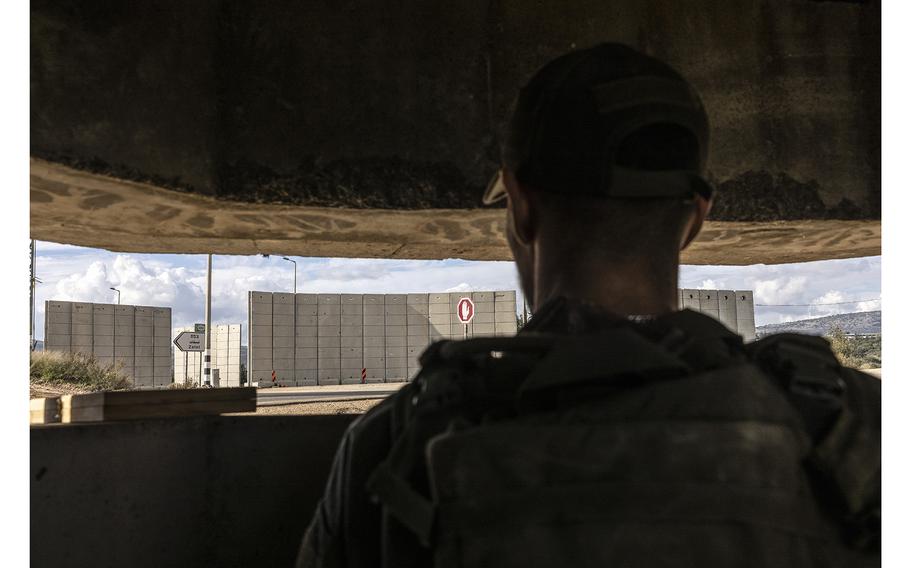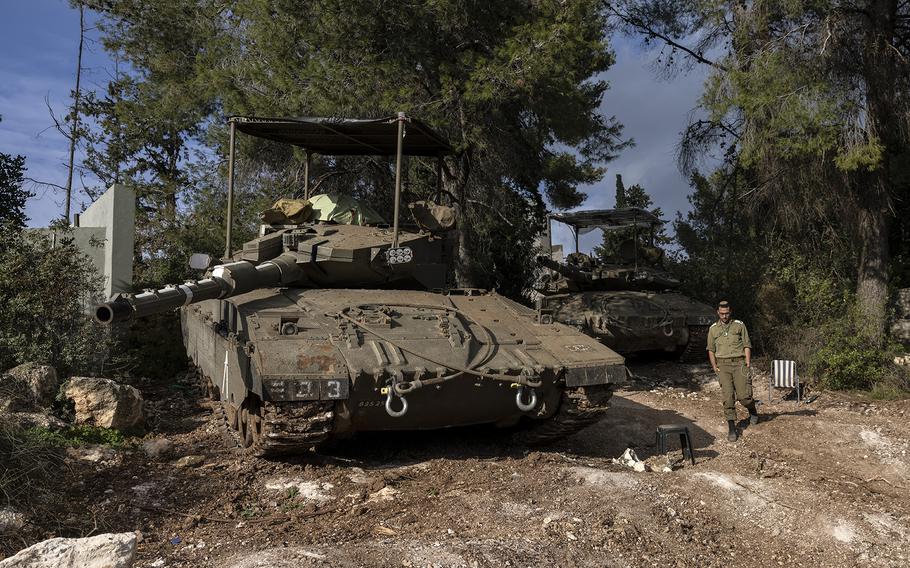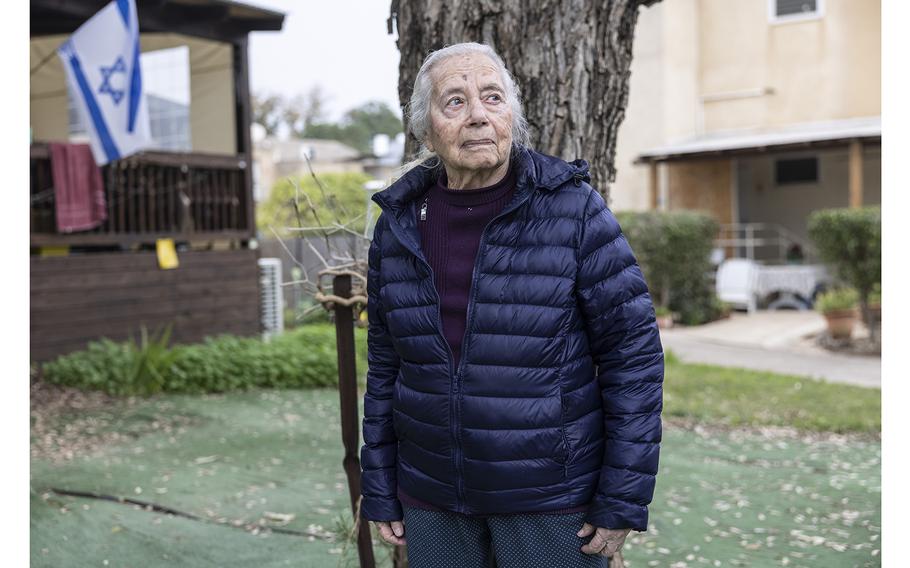
Naveh, an Israeli soldier who was previously fighting in Gaza, guards a road near a cement barrier wall close to the Israel-Lebanon border that was erected after Oct. 7., 2023. (Heidi Levine for The Washington Post)
EILON, Israel - For years, David Shtift tried to convince the Israeli army that Hezbollah militants, a mile away in Lebanon, would make good on their threats to attack Israel.
Shtift and his neighbors said they saw Hezbollah special forces amassing along the border and establishing lookout posts in structures allegedly built for environmental protection. Sometimes, they heard what sounded like the digging of underground tunnels. The army claimed Israel’s enemies were deterred, its borders impenetrable.
But the kibbutz, unwilling to take their chances, rounded up funds and drafted contingency plans - buying long guns for its 25-member local defense unit, securing emergency sources for water and electricity and building a military clinic.
On Oct. 7, when thousands of fighters led by Hamas - the Gaza-based militant group with increasingly close ties to Hezbollah - breached Israel’s southern border, slaughtering 1,200 people and taking 240 more hostage, Shtift sensed, bitterly, that they had been right to worry.
“What happened in the south was exactly what we were saying could happen here, and still could,” said Shtift. “It’s real.”
At least 70,000 Israelis from the northern border have evacuated their homes in the wake of the attack, turning the area - like the devastated south - into a closed military zone. Several Israeli battalions, comprising thousands of soldiers, have moved in. Across the border, Hezbollah fighters trade fire.
This is not an official war zone. Yet explosions from Israeli artillery and Hezbollah missiles echo across the rock-strewn mountains nearly every day. Israel’s military says Hezbollah has used short range mortars, Russian “Kornet” antitank missiles and thermobaric bombs to destroy homes in the Israeli kibbutzim.
More than 100 Hezbollah fighters and at least 20 civilians, including three journalists, have been killed in Lebanon. Twelve soldiers and five civilians have been killed on the Israeli side.
On Tuesday, a suspected Israeli airstrike in Beirut killed Saleh Arouri, a senior Hamas official who helped the group nurture its ties with Hezbollah and was designated by the U.S. as a “global terrorist.”
The strike heightened fears in the region that the skirmishes along this volatile borderland could explode into all-out war. Hezbollah, unlike Hamas, is regarded by Israel as a proper army with sophisticated training and an arsenal of some 150,000 missiles. Many Israelis fear their government is, once again, underestimating a deadly threat.

Ezra, an Israeli reservist soldier by his tank near the Israel-Lebanon border on Thursday, Jan. 4, 2023. (Heidi Levine for The Washington Post)
Hasan Nasrallah, Hezbollah’s leader, warned in a speech Wednesday that retaliation for Arouri’s assassination was coming. And if Israel were to wage war on Lebanon, he said, it would be “very, very, very costly.”
Moshe Davidovich, the head of a local council who sent 40,000 people packing even before the official evacuation order came in, said many residents saw the battle on the northern front as a fight for their homes. But they struggled, he said, with where they would live and how they would get their children to school. And they didn’t trust their “nongovernment” in Jerusalem, Davidovich said, where leaders are “consumed with politics and tactics - no strategy.”
For the unprecedented number of Israeli evacuees, from north and south, the state has seemed largely absent. It took weeks for authorities to facilitate hotel stays and rental agreements. And northerners have been given few answers about the state of their homes or a timeline for when they will be able to return.
Israel’s government may again be relying on “the illusion that agreements can be made with our enemy,” said Davidovich, before pausing to take a call from Prime Minister Benjamin Netanyahu’s office.
“Until Oct. 6, we were seen as the sheriff of the Middle East. After Oct. 7, we are being viewed as having lost our capability to deter,” he said. “There is no question for us but to regain that.”
Israel is negotiating with the Lebanese government and representatives of Hezbollah - the country’s dominant military and political force - to de-escalate the situation. But on Thursday, Israeli Defense Minister Yoav Gallant told Amos Hochstein, a senior White House envoy, that there is only a “short window of time” for a diplomatic solution.
“We will return our citizens in the north and in the south,” Netanyahu said Thursday. “For that we’ll apply maximum power with maximum precision everywhere that’s needed.”
But many along the northern border have no faith in Netanyahu, who told Israelis for years that Hamas was contained in Gaza. Similar assurances about Hezbollah will be a hard sell here.
“What was before Oct. 7 can never be again,” said Dotan Razili, a reserve soldier serving in his hometown of Kibbutz Eilon. He pointed to the zigzagging border wall - part concrete, part barbed wire, reinforced by high-tech sensors and cameras that feed into monitors in nearby military bases. After Hamas used grenade-laden drones and snipers to shoot out the cameras along the Gaza border, the “smart wall” no longer feels sufficient, he said.
“We fell in love with technology and forgot some very critical and basic things,” said Razili.

Rachel Rabin, sister of the late Prime Minister Yitzhak Rabin, was evacuated from her home in Kibbutz Manara due to rising tensions between Hezbollah and Israel. (Heidi Levine for The Washington Post)
He said his units have embraced low-tech solutions, relying on IDF strategy manuals from the 1950s and old-fashioned two-way radio telephones.
Though Hezbollah forces have been retreating from the border in recent weeks, he said, after Oct. 7, “no Israeli can ever say that it could never happen again.”
Israeli officials are floating the idea of buffer zones - similar to the one that existed when Israel occupied southern Lebanon from 1985 to 2000 - extending around 4 kilometers (2.5 miles) inside southern Lebanon and several kilometers inside Gaza, an enclave that is only 12 kilometers (7.5 miles) wide. Netanyahu has also said that Israel wants to control the Philadelphi Corridor, running along the Gazan border with Egypt.
Yossi Harpaz, a sociologist at Tel Aviv University, said that there has been a shift in Israel perception of defense - and the role of its border towns - after Oct. 7.
“The buffer zone is now in our own territory, in the border areas,” he said, populated now by soldiers rather than civilians. Oct. 7 was also a “violation of the IDF doctrine, to take the fight to the territory of the enemy.”
Noam Erlich ran a craft beer company out of Kibbutz Manara, a northern community evacuated for the first time in its history on Oct. 8. Including his, 86 of the town’s 155 homes have been destroyed. He sees the strength of frontier kibbutzim like Manara as a matter of national security.
“If Manara goes, then the next border line will be Kiryat Shmona,” he said, referring to another Israeli city farther from the border. “Slowly, Israel’s northern border will reach Tel Aviv.”
“The kibbutzim cannot exist without the collaboration of the government, and the government and the infrastructure have been collapsing,” said Tirtsa Valentine. Her mother, Rachel Rabin, was among the founders of Kibbutz Manara, and the sister of slain Israeli Prime Minister Yitzhak Rabin, the last Israeli leader to get close to a peace deal with the Palestinians.
“Buffer zones don’t work,” she said. “And if the only solutions that are being discussed are the ones that just go from one war to the next, then we’re in trouble.”
Sarah Dadouch in Beirut contributed to this report.